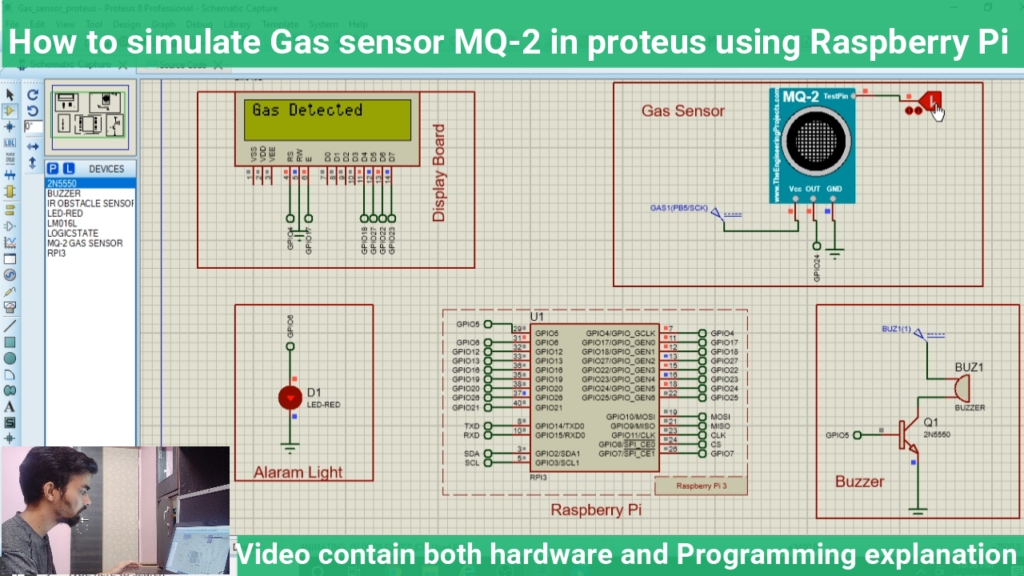
Description:
- This research project focuses on simulating the Gas Sensor MQ-2 in the Proteus software environment, leveraging a Raspberry Pi to detect the presence of potentially hazardous gases, especially for fire detection. The project aims to create a reliable and cost-effective solution for gas sensing and fire alarm applications using virtual simulations.
- The key objectives of this project are as follows:
- Gas Sensor MQ-2 Simulation: The Gas Sensor MQ-2 is a widely used sensor for detecting various flammable gases such as LPG, butane, methane, alcohol, and hydrogen. The simulation involves modeling the MQ-2 sensor’s behavior in Proteus, replicating its response to the presence of specific gases.
- Raspberry Pi Interface: The Raspberry Pi serves as the core of the system, acting as the interface between the simulated MQ-2 sensor and the virtual fire alarm. It processes sensor data, analyzes gas concentrations, and triggers appropriate actions based on the detected gas levels.
- Fire Detection Algorithm: The fire detection algorithm is implemented in the Raspberry Pi to process the simulated MQ-2 sensor data. It analyzes the gas readings and identifies patterns indicative of potential fire hazards.
- Virtual Fire Alarm: Upon detecting dangerous gas levels consistent with a fire hazard, the Raspberry Pi activates a virtual fire alarm in the Proteus simulation. The alarm could be in the form of a visual indicator, an audible buzzer, or both, providing a clear and immediate indication of the fire threat.
- The simulation process involves the following steps:
- a. Gas Sensor Simulation: The Gas Sensor MQ-2 is virtually interfaced with the Raspberry Pi in Proteus, replicating its analog output corresponding to the gas concentration levels. The simulation environment is calibrated to produce realistic sensor responses to varying gas concentrations.
- b. Raspberry Pi Integration: The Raspberry Pi is virtually configured to receive the analog sensor data and execute the fire detection algorithm. The sensor readings are processed in real-time, and the algorithm determines the presence of a fire based on predefined threshold values.
- c. Fire Alarm Activation: Upon identifying a potential fire hazard, the Raspberry Pi activates the virtual fire alarm in the simulation. The alarm interface responds immediately, alerting the user about the detected fire and the associated gas levels.
- The project’s success is evaluated based on the accuracy and responsiveness of the virtual gas sensor and fire detection system. Additionally, the feasibility and practicality of implementing the proposed solution using real-world hardware are analyzed.
- In conclusion, this research aims to demonstrate an effective and efficient method for simulating the Gas Sensor MQ-2 in Proteus using a Raspberry Pi for fire detection and alarm applications. The project seeks to provide a virtual environment to test and optimize the gas sensing system’s performance, potentially serving as a foundation for real-world implementations in fire safety and monitoring systems.
Software Require:
- You need to install the Proteus 8.9 version in your laptop.
- You also need to install MQ2 sensor library in your proteus software .
- Detail steps explain in YouTube Video.
Project Code:
- Download project code from below button. If you want to understand code explanations then please watch YouTube video.
YouTube Video:
- If you want to understand how to connect hardware with Raspberry Pi,
- And Program explanation for this project,
- And how to do this project by yourself then please watch our YouTube video.
Purchase Readymade Project:
- If you want to purchase a readymade project from Mytrained.com then contact us on whatsapp.
- We do not encourage any student to purchase a readymade project from us. Our mission is to give complete knowledge free of cost.
- So from our end we already provide code and detailed steps to create this project by yourself in our YouTube video.
- So if you want to save your money then watch our video and follow the steps that are mentioned in the video.
- Once you purchase a project then it will take at least 1 month to design your project.
- You have to pay the complete project cost while placing the purchase order.
- no refund no exchange policy


Leave a Reply